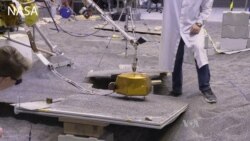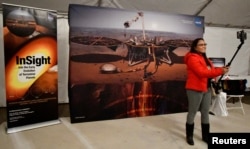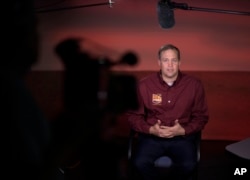The U.S. Space Agency NASA says that its latest Mars probe has successfully touched down on the Red Planet with a unique mission to explore Mars' interior.
After traveling hundreds of millions of kilometers through space over the course of six months, the probe, called InSight, landed safely Monday on the Martian surface.
WATCH: Mars landing
Engineers at the Jet Propulsion Laboratory in Pasadena, California erupted with cheers as they received data showing that the spacecraft had survived a dangerous descent to the Red Planet.
"Touchdown confirmed!'' a flight controller announced. Minutes later, controllers received a photograph of the probe's new surroundings on Martian soil.
'Amazing day'
The spacecraft took a crucial six and-a-half minutes to enter Mars' atmosphere, descend and land. During that time, InSight decelerated from an initial speed of 19,300 kmh (12,000 mph) down to just 8 kmh (5 mph) when it touched down. To aid the landing, scientists equipped InSight with a parachute, descent thrusters and shock-absorbing legs.
"What an amazing day for NASA," said agency administrator Jim Bridenstine. He said Vice President Mike Pence called him seconds after touchdown to congratulate everyone who worked on the project.
NASA has pulled off seven successful Mars landings in the past four decades, with one failed touchdown. The space agency last attempted a landing on Mars six years ago when the Curiosity rover successfully reached the Red Planet in 2012.
Excitement about the latest landing was high, with viewing parties held across the United States. The giant NASDAQ screen in New York's Times Square broadcast NASA TV on Monday afternoon.
After the probe landed, there was a communication lag of eight minutes before scientists on Earth could tell if the touchdown was successful. A pair of satellites that trailed InSight since its liftoff in May relayed radio signals to Earth about the probe, but those messages took eight minutes to reach NASA scientists.
"Every milestone is something that happened eight minutes ago," Bridenstine said.
After InSight touched down, it waited 16 minutes to allow the dust that it kicked up to resettle. A few hours later, NASA confirmed the spacecraft deployed its solar arrays that convert sunlight into electricity. That is a critical step that will allow the lander to power itself for the next two years.
"We are solar-powered, so getting the arrays out and operating is a big deal," said Tom Hoffman, Insight's project manager.
InSight has a battery system, but it stores only enough energy to power the probe for one day.
During a post-landing NASA press conference, the astronauts on the International Space Station called down to congratulate the scientists who worked on InSight.
Scientists carefully chose where they wanted the probe to land, selecting a large volcanic plain named Elysium Planitia because it has few rocks and less chance of wind gusts that could potentially knock over the lander.
By the time it landed, InSight had traveled 484 million kilometers (300.7 million miles). However, since it is not a rover, it cannot move across the Martian surface. Scientists say it was critical that InSight landed in the correct location because wherever it landed is where it will stay.
Insight has a unique mission to explore Mars' interior. While other missions to Mars have sought to better understand the planet's surface and atmosphere, this is the first to focus exclusively on what is under the planet's surface.
Mission set to last a year
The $850 million InSight mission is planned to last 24 months or about one Martian year — and will try to gather an array of information, including Mars' below-ground temperature and seismic activity, as well as to carry out an underground mapping project. Insight is armed with a crane, heat probe and seismometer and is able to hammer 5 meters (16.4 feet) below the surface.
Scientists are hoping the mission will help answer questions about the composition and evolution of the planet and whether Mars was formed from the same mixture of materials as Earth.
Bridenstine says he is hopeful that Insight can also provide crucial information about whether there is liquid water on Mars.
Bruce Banerdt, InSight's principal research scientist, said the mission has been 10 years in the making. "But even after landing, we'll need to be patient for the science to begin," he said.











